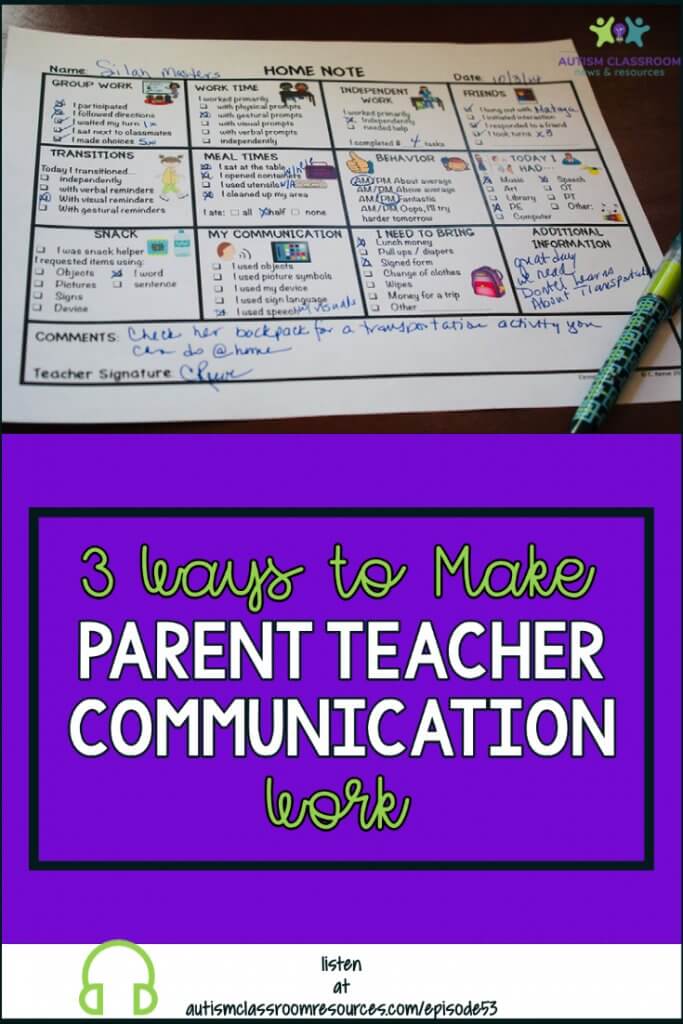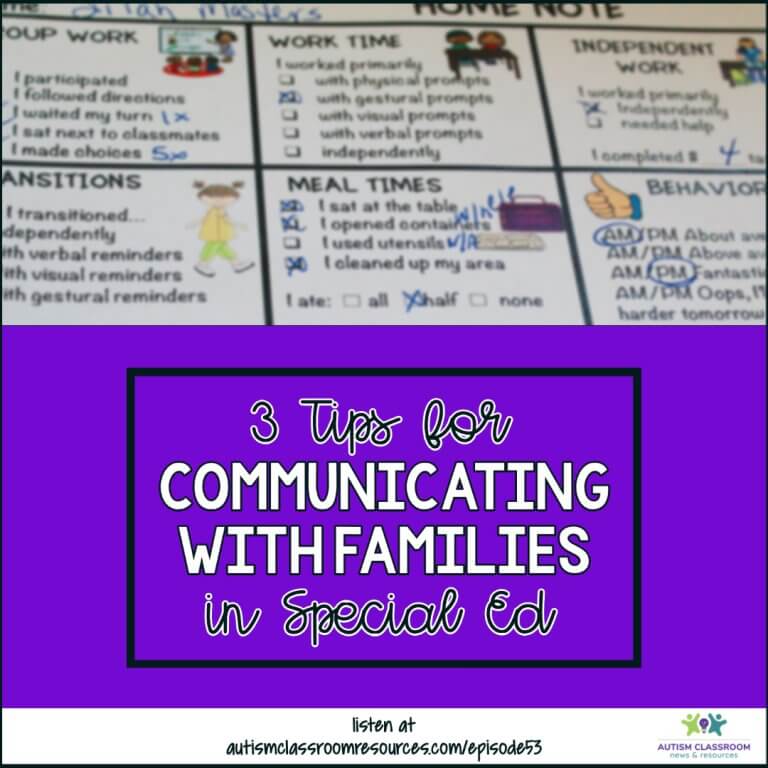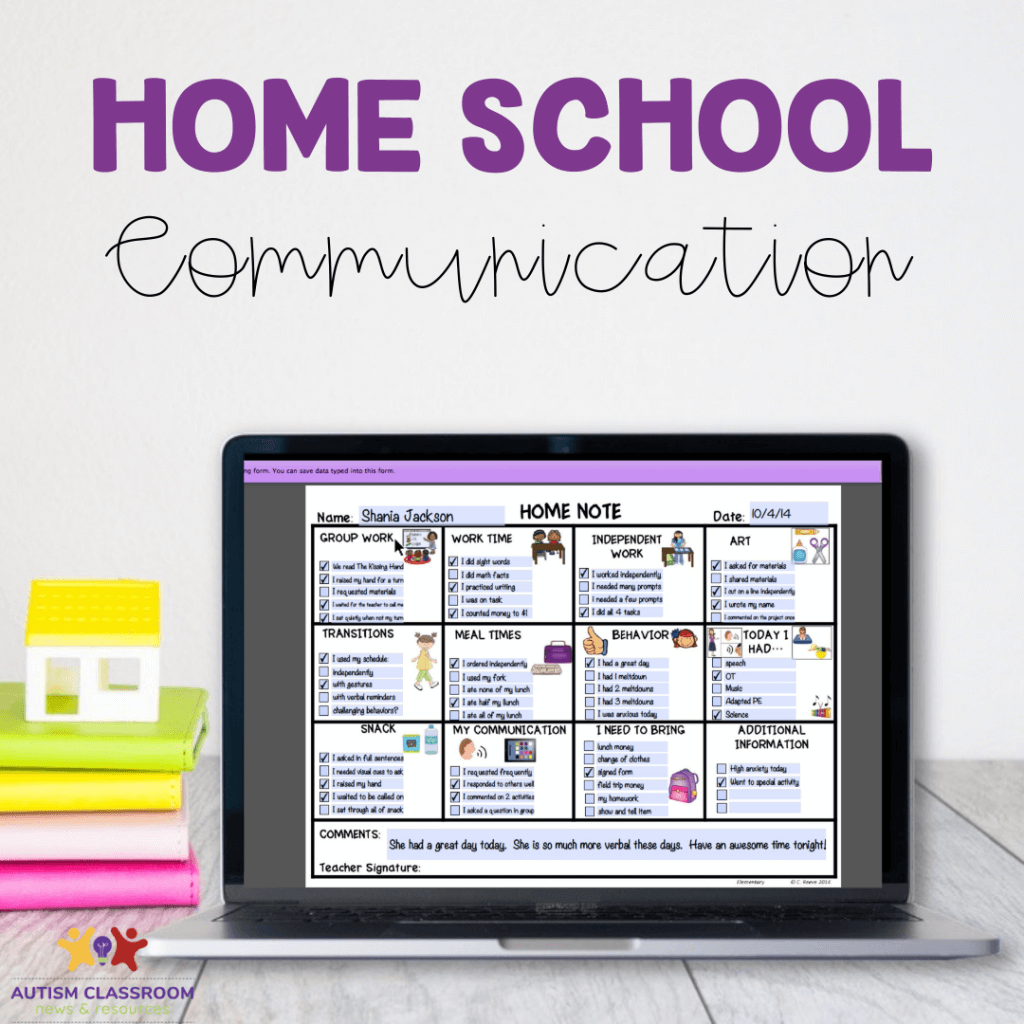Today I want to talk about teacher parent communication which is about five times more important in the crazy times that we’re living in when I’m recording this in fall of 2020. But it’s pretty important all the time, I think, in special education. And that’s because many of our students struggle to communicate information between parents and teachers.
It may not make it home or the information we need may not come back to us. Other of our students may not always be the most reliable reporters of information. So having a channel between teachers and families is critical for the successful collaboration in their child’s education. But teacher and parent communication has been a huge challenge across the board, but especially in distance learning.
And I know that a lot of you are really struggling with it. You may not see the parents, and they may not know that their child isn’t turning in assignments or isn’t logging on. Or you may be having difficulty getting information from the families about what they need in order to facilitate their child’s program. But even in the classroom and in school building, building relationships with families is a critical part of our job. Our students make better progress when their teachers and families work together. And to do that, both teachers and families need information about what is happening with students in each setting.
3 Ways to Enhance Teacher Parent Communication in Any Setting
In this episode, I’ve got three ways that can help you easily, efficiently and effectively communicate with families. And hopefully to get information back from families as well because we know that communication needs to go both ways.
Some of the characteristics I look for in a communication system, because you know I love a good system, include ease, efficiency and usefulness. It has to be easy to use without taking a ton of time. Could you keep a running log of everything? The student does it school. I suppose you could do that theoretically. But I’m not theoretical. I’m practical and if you can’t use something in your everyday classroom it’s not going to work. And, frankly, that just takes you away from the instruction you need to provide to your students.
What Works for Teacher Parent Communication?
Consequently, I tend to shy away from communication notebooks and logs. It’s a lot of writing time, and you can spend that time better engaged with your students. There just isn’t time for that every day. Sometimes it’s needed, but not as our primary method of regular communication. So these three ways I’m going to talk about for communication with families will meet these characteristics.
- They’re easy to use
- They provide concrete information about activities issues and performance.
- They can provide options for families to respond and share information
- They don’t require lots of time to complete on either side of the communication and to help with all this.
I’ve got a free download in the free resource library that I talk about in the episode. And you could grab it and a transcript at autismclassroomresources.com/episode53.
I’ve got a free Google Form I created for the Special Educator Academy for the members to be able to edit and use with their families. We have lots of resource is like this in the Academy, and it’s a great place to interact with me and with our amazing other special educators. So if you want, come join us for a free seven day free trial at specialeducatoracademy.com. Now let’s get started.
#1 Structured Home Notes for Teacher Parent Communication
So the first method I want to talk about for communication with families is structured home notes. I like home notes that have checkoff systems for different activities. And they could be personalized for the families and the information that they want. I like them for a variety of reasons. I have some in my store. You can find them in the blog post for this episode. I have them for all different ages, but I like them because they’re concrete and they’re positively stated.
Checkoff System is Efficient
It’s a checkoff system, but you can always add information. But one of the things I really like about a checkoff system is that the paraprofessionals can complete it when they’re with the student. And that gives you information. But you read over it, review it and send it back to send it to the parents. So that note is still coming from the teacher. I also really like that it’s concrete about specific skills. So sometimes families want to know how much their child ate at school. Then I check off “I ate nothing. I ate a little bit. or I ate most of my lunch. or ate none of my lunch. Sometimes its behavior. I’m not a real fan of the happy face, sad face system.
So what is meaningful for families? You could check off general levels of prompting for independence and independent work. I like the fact that the information is concrete. I like the fact that it’s specific but positively stated. What did they do, instead of what the problems were? That means that I know I’m sending positive information home as well as things that families need to know that aren’t so positive.
Structured Notes Remind You What to Communicate
The other reason I really like them is because the sections serve as good reminders to the teacher about what the student needs to bring to school and remembering to tell mom and dad about that. What the mom needs to email you. Making sure that you remember to tell them what special they went to, how it went today, and things like that.
Now the ones that I have in the blog post can be edited. You can add information and make your own categories in PowerPoint. And you can also email them to parents. So they work really well. Whether in a building, you have a print version. r if you are in a distance learning and you need something that you can send electronically.
Keep a Copy for a Record of Teacher Parent Communication
I’m also a big fan of anything that allows me to keep a copy. Because once I send something home I shouldn’t expect or require that it come back because I don’t have control over it. So I can certainly ask the families to send it back. But I don’t want that to be that the only record that I have of my communication with families ends up being held by the families. I need to have a copy of that, too.
Picture Cues and Return Form
I also like adding picture cues, which these sets have so that students can learn to talk about their day. And it gives the parents of picture cue to cue them to talk about what happened in music today and things like that.
There’s also a page to get information back from families, and I think that’s an important component. No, not every family does it. No, they don’t do it every day. I wouldn’t necessarily expect them to do it every day, But I do get it more often than I would if it wasn’t there. So information like how did they sleep last night? What did they watch on TV? Did they have visitors? Because that allows you to build your conversation with the student if you know what’s happening. And that could also go back and forth by email.
#2 Remind.com For Teacher Parent Communication
The second option is to use something like Remind or other management systems, like Class Tag. Remind just happens to be one of this familiar with. Remind is a text system. You set up a class and your families join it. And then you can send them private texts back and forth. You can send group texts if you have an announcement for everybody. But then you can also send messages directly to the family.
Set Boundaries
One of the things that’s nice about it is, instead of just using your cell phone, it allows you to set office hours. And it’s critical that you need to be setting limits for yourself, especially if you’re doing distance learning. Because it’s really easy to let those hours bleed into the rest of your day. And while I am all for being available to families, you have to set boundaries. Everybody has to set boundaries about when they can respond to things. It allows you to set up those kinds of boundaries and let the families know ahead of time when you will respond. You could also create a template and use Remind to send it home as an attachment.
#3 Google Forms for Teacher Parent Communication
And finally, the third option are Google Forms. There is a free one that is a really easy online way to send home information about the classroom and to ask for specific feedback from families. Now at autismclassroomresources.com/episode53 I have a free Google Form survey for you.
It has three simple questions because if you’re going to ask parents to respond to and not overwhelm them with too many questions. So I limited it to three, which is my new magic number. It’s designed to get information from families about what’s working and not working in distance education and how their family is doing on what struggles they’re having. And what’s going well is also in there. I think that all of that is important with everything else that’s going on in our world.
You can create your own Google form. You can take that one and edit a Google form, and you could use it to send information home as well as get information back. So maybe once a week, you want to know what did they do this weekend? Or what are your plans for this weekend so that you have something that you could build conversation to talk to your students.
Allows Quick Responses for Families
Google forms could be a really good, structured way to get information from families quickly and easily without having to make contact by phone. That’s sometimes hard when your schedules don’t jive by making it a form instead of just an email. You could use a rating scale where you just check off the box, you could have a checklist for families to respond back to you. So it’s not that they have to write out a whole narrative answer. It gives you lots of tools that you can use, and you’ll see those in the free download. And that makes it less overwhelming for them. You can also make it structured in the form that you sent home so that you’re regularly giving positive information and giving the type of information you want to make sure that you touch base with them on each day or each week.
How Often do Families Want Communication?
And you can also ask families how often they want communication. I haven’t really talked about that a lot, but some families may rather have more information weekly than little information every day. That may also makes sense for some of your students.
Teacher Parent Communication From the Teacher
The other thing that’s good about Google Forms is that, just like with the structured home notes, your paraprofessionals can complete it. They could complete it on their devices. You can then check over it, ask any questions that you need. You know what information’s going home. And again it gets sent from you.
The reason I think that is important is a the teacher is in charge of the classroom, but you’re not with the students all the time. And that means you’ve got to get information from paras. But you don’t want to be blindsided from it by information that family members get directly from paras. That information needs to go through you so that you can address it. Otherwise you don’t have that opportunity.
Summary
So those are three ways that you could make your regular communication with families productive, positive and less overwhelming, I hope. I think it’s really important that whatever you’re using, its positive, it is clear, and it is concrete information rather than just Good day, Bad day. Because it doesn’t really tell you what that means. Being as specific as you can without spending long amounts of time in writing is the sweet spot that you’re trying to hit.
I’d love to hear about what you’re doing for communication. If you’re an educator, hop over to specialeducatorsconnection.com. Answer the questions to join our free Facebook group and share there. And you can grab a transcript and information about the home notes that are in my stores and the free copy of your Google survey at autismclassroomresources.com/episode53
And finally, I would really love it if you would just take a moment to leave me review and your favorite podcast app to get re sources and ideas sent out and attract other educators who could benefit from this across the country And, of course, as always, thank you so much for your time and for everything you do. I hope to see you again next week.








